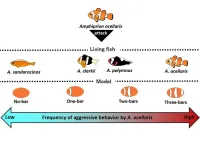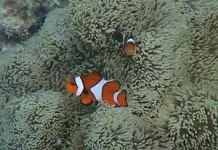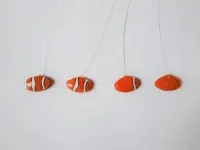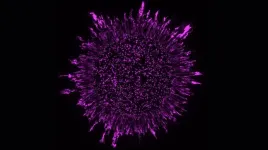(Press-News.org) We often think of fish as carefree swimmers in the ocean, reacting to the world around them without much forethought. However, new research from the Okinawa Institute of Science and Technology (OIST) suggests that our marine cousins may be more cognizant than we credit them for.
By observing how a colony of clown anemonefish (Amphiprion ocellaris) – the species of the titular character in Finding Nemo – reacts to intruders in their sea anemone home, OIST researchers have found that the fish recognize different anemonefish species based on the number of white bars on their bodies. “The frequency and duration of aggressive behaviors in clown anemonefish was highest toward fish with three bars like themselves,” explains Dr. Kina Hayashi from the Marine Eco-Evo-Devo Unit at OIST, first author on the paper published in the Journal of Experimental Biology, “while they were lower with fish with one or two bars, and lowest toward those without vertical bars, which suggests that they are able to count the number of bars in order to recognize the species of the intruder.”
The clown anemonefish is normally a gracious host, allowing many different species to visit their sea anemone. However, should a member of their own species, and which is not part of the colony, enter their home, the largest fish of the colony, referred to as the alpha fish, will aggressively bite and chase out the intruder.
To figure out how these fish determine the species of their visitors, Dr. Hayashi and colleagues conducted two sets of experiments with immature clown anemonefish raised in the lab. In the first set, they placed different species of anemonefish, with different numbers of white bars, in small cases inside a tank with a clown anemonefish colony and observed how often and for how long the fish would aggressively stare at and circle the case. In the second set, the researchers presented a colony of clown anemonefish with different plastic discs painted with true-to-life anemonefish coloration and measured the level of aggression towards these models.
The clown anemonefish displayed the most aggressive behavior towards the intruders with three bars like themselves. Fish and plastic models with two bars were attacked slightly less frequently, while the ones with one or zero bars received the least aggressive response. Previous studies have shown that clown anemonefish react much stronger to models with vertical rather than horizontal bars, suggesting that the amount of white color or the general presence of white bars is not the deciding factor. Combined with the observation that the plastic discs, which have no species defining traits other than the vertical bars, received the same response as the live fish, lead the researchers to suggest that the fish appear to be counting the number of vertical white bars to inform their level of aggression toward intruders.
The researchers also discovered a strict hierarchy in the clown anemonefish colonies that determines which fish attack the intruder. In the wild, a colony typically consists of one alpha female, one beta male, and several gamma juveniles. The social position within the colony is determined by very slight differences in size. Anemonefish get their third and final stripe when they metamorphize into either a male or female when they grow large enough, which is why the current alpha uses harsh methods to uphold the status quo, including chasing out colony members if they grow too large.
Though the researchers used immature fish that have yet to metamorphize into males or females, they still observed the same size-based hierarchy, with the largest juvenile taking on the role of alpha and leading the charge against the intruder.
“Anemonefish are interesting to study because of their unique, symbiotic relationship with sea anemones. But what this study shows is that there is much we don’t know about life in the marine ecosystems in general”, says Dr. Hayashi. The study is a sobering reminder to preserve the fragile coral reefs that fish like the anemonefish inhabit. If the clown anemonefish, which is popular both as a pet and in the media, can surprise us with their abilities to count bars and maintain strict social hierarchies, then it begs the question of how many remarkable animals and animal behaviors have yet to be discovered in these ecosystems under threat.
END
Clown anemonefish seem to be counting bars and laying down the law
New research suggests that the fish may be counting vertical bars on intruders to determine their threat level, and to inform the social hierarchy governing their sea anemone colonies.
2024-02-01
ELSE PRESS RELEASES FROM THIS DATE:
New research shows that the arrangement of bacteria in biofilms affects their sensitivity to antibiotics
2024-02-01
Bacteria are traditionally imagined as single-cell organisms, spread out sparsely over surfaces or suspended in liquids, but in many environments the true bacterial mode of growth is in sticky clusters called biofilms. Biofilm formation can be useful to humans—it is integral, for example, to the production of kombucha tea. But it is more often problematic, because it makes it more difficult to control bacterial growth: When bacterial cells produce a biofilm, it acts as a shield against outside invaders, making the bacteria more ...
First atomic-scale 'movie' of microtubules under construction, a key process for cell division
2024-02-01
· Researchers at the Centre for Genomic Regulation (CRG) , the Spanish National Cancer Research Center (CNIO) and the IBMB-CSIC solve a key problem in biology: how human cells build their microtubules
· During cell division, microtubules function as nanometer-thick long ‘ropes' inside cells that pull chromosomes apart so that each daughter cell receives a copy of the genetic material
· The work published in Science lays the groundwork for future breakthroughs in the treatment of diseases ranging from cancer to neurodevelopmental disorders
Cells in the human body are constantly dividing. With each division the genetic information contained in the ...
Mapping the structure and organization of hippocampal neurons in the mouse brain
2024-02-01
Single-cell projectome analysis has revealed previously unknown spatial organization principles of the brain-wide structure and connectivity of more than 10,000 individual hippocampal neurons in the mouse brain, according to a new study. Specialized projections called axons allow neurons to transmit signals to other neurons across the brain. The hippocampus (HIP) – one of the most extensively studied brain regions – plays a crucial role in many crucial brain functions, including learning, memory, ...
Large herbivores’ effects on ecosystems depend more on size and diet than on herbivore origin
2024-02-01
The effect of large herbivores on plant abundance and diversity depends more on their size and diet than whether they are native or introduced into their host ecosystems, according to a meta-analysis of more than 200 studies worldwide. The findings counter the widely held notion that the impacts of introduced megafauna are distinct and more harmful than those of native megafauna and suggest that trait-based ecology provides better insight into megaherbivore-plant interactions than concepts of species origin. Large mammal herbivores play a key role in shaping ecosystems and biodiversity by consuming vegetation, dispersing seeds and nutrients, and creating ...
The evolution of sign languages globally revealed through computational analyses
2024-02-01
A computational analysis has highlighted the poorly understood relationships and elusive histories of modern sign languages worldwide, revealing two major sign language families shaped by geopolitical forces and relevant signing communities. The findings show that the computational methods applied – which have been useful in understanding spoken languages – can be extended to the study of sign languages; as such, they offer promise for addressing the disparities in our understanding of other marginalized and diverse ...
AI system reveals new insights into early language acquisition through the experience of a single child
2024-02-01
A new machine learning model – trained on video and audio recorded from the first-person perspective of one young child for over a year – has provided new insights into early language acquisition. Not only do the findings offer a valuable framework to understand how children learn words and concepts, but they could be critical in developing artificial intelligence (AI) systems that can learn language in more human-like ways. Beginning around 6 to 9 months of age, children begin acquiring their ...
Targeting treatment resistance in chronic lymphocytic leukemia
2024-02-01
MIAMI, FLORIDA (EMBARGOED UNTIL FEB. 1, 2024, AT 2 P.M. ET) – New research from Sylvester Comprehensive Cancer Center at the University of Miami Miller School of Medicine and collaborating organizations has identified a next-generation BTK degrader that could help overcome treatment resistance in chronic lymphocytic leukemia (CLL) and related blood cancers.
Their findings, published Feb. 2 in the journal Science, could offer a therapeutic option for CLL patients whose tumors become drug-resistant or are unresponsive to frontline treatment.
“This new compound not only inhibits the cellular molecule BTK, but goes further by taking aim at the target ...
Sustainable carbon removals limits identified, huge climate mitigation challenge revealed
2024-02-01
*Embargoed until 14:00 US Eastern / 19:00 UK GMT / 20:00 Europe CET – Thursday 1 February*
Governments and businesses are relying on dangerous amounts of future removal of carbon dioxide (CO2) from the atmosphere, instead of more rapidly reducing emissions and phasing out fossil fuels. This problem is partly due to an incomplete picture1 of the damaging consequences of carbon dioxide removal for people, food security and natural ecosystems, according to new research published in Science.
The paper finds that the carbon dioxide removal potential currently reported by the UN ...
Whole-brain projection patterns of single neurons in mouse hippocampus unveiled
2024-02-01
A study published in Science on Feb. 1 reported a comprehensive database of single-neuron projectomes consisting of over 10,000 mouse hippocampal neurons, thus revealing the spatial connectivity patterns of mouse hippocampal neurons at the mesoscopic level.
The study was conducted by teams from the Center for Excellence in Brain Science and Intelligence Technology (CEBSIT), the Institute of Neuroscience of the Chinese Academy of Sciences (CAS), the HUST-Suzhou Institute for Brainsmatics, Hainan University, the Kunming Institute of Zoology of CAS, Lingang Laboratory, and the Shanghai Center for ...
New study suggests culling animals who ‘don’t belong’ can be a flawed nature conservation practice
2024-02-01
New research published today in the journal Science has concluded that eradicating animals on the basis that they are not native in order to protect plant species, can be a flawed practice costing millions of dollars, and resulting in the slaughter of millions of healthy wild animals.
Introduced large herbivores, or megafauna, are claimed to have distinct and harmful ecological impacts, including damaging sensitive plants and habitats, reducing native plant diversity, and facilitating introduced plants. However, up to now these impacts have been studied without comparison to a proper ...
LAST 30 PRESS RELEASES:
Longest observation of an active solar region
Why nail-biting, procrastination and other self-sabotaging behaviors are rooted in survival instincts
Regional variations in mechanical properties of porcine leptomeninges
Artificial empathy in therapy and healthcare: advancements in interpersonal interaction technologies
Why some brains switch gears more efficiently than others
UVA’s Jundong Li wins ICDM’S 2025 Tao Li Award for data mining, machine learning
UVA’s low-power, high-performance computer power player Mircea Stan earns National Academy of Inventors fellowship
Not playing by the rules: USU researcher explores filamentous algae dynamics in rivers
Do our body clocks influence our risk of dementia?
Anthropologists offer new evidence of bipedalism in long-debated fossil discovery
Safer receipt paper from wood
Dosage-sensitive genes suggest no whole-genome duplications in ancestral angiosperm
First ancient human herpesvirus genomes document their deep history with humans
Why Some Bacteria Survive Antibiotics and How to Stop Them - New study reveals that bacteria can survive antibiotic treatment through two fundamentally different “shutdown modes”
UCLA study links scar healing to dangerous placenta condition
CHANGE-seq-BE finds off-target changes in the genome from base editors
The Journal of Nuclear Medicine Ahead-of-Print Tip Sheet: January 2, 2026
Delayed or absent first dose of measles, mumps, and rubella vaccination
Trends in US preterm birth rates by household income and race and ethnicity
Study identifies potential biomarker linked to progression and brain inflammation in multiple sclerosis
Many mothers in Norway do not show up for postnatal check-ups
Researchers want to find out why quick clay is so unstable
Superradiant spins show teamwork at the quantum scale
Cleveland Clinic Research links tumor bacteria to immunotherapy resistance in head and neck cancer
First Editorial of 2026: Resisting AI slop
Joint ground- and space-based observations reveal Saturn-mass rogue planet
Inheritable genetic variant offers protection against blood cancer risk and progression
Pigs settled Pacific islands alongside early human voyagers
A Coral reef’s daily pulse reshapes microbes in surrounding waters
EAST Tokamak experiments exceed plasma density limit, offering new approach to fusion ignition
[Press-News.org] Clown anemonefish seem to be counting bars and laying down the lawNew research suggests that the fish may be counting vertical bars on intruders to determine their threat level, and to inform the social hierarchy governing their sea anemone colonies.





